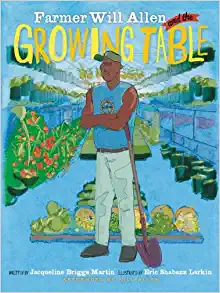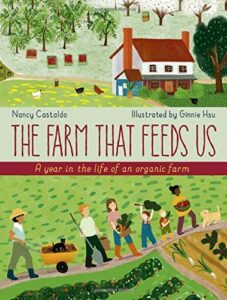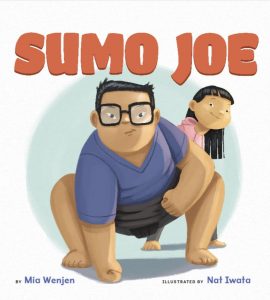Today’s list is all about sustainable farms, to find friends for my newest picture book, Food for the Future. What are your favorite books on sustainability and/or farms? Thanks for sharing!
I’m giving away 25 copies of Food for the Future.
Please fill out this form to get a copy.
Children’s Books about Sustainable Farms
Food for the Future: Sustainable Farms Around the World by Mia Wenjen, illustrated by Robert Sae-Heng
Go on a tour of eco-friendly farms around the globe! From urban gardens to farms under the sea, discover the many different sustainable ways people have been growing food for centuries, and new innovations that are battling the effects of climate change on farming. Rhyming text and inset boxes with definitions for new vocabulary words make the topic accessible to young learners. End matter includes detailed information about each country’s farming practice, sustainable farming, and more. [picture book, ages 3 and up]
The Good Garden: How One Family Went from Hungry to Having Enough by Katie Smith Milway, illustrated by Sylvie Daigneault
In the hills of Honduras, Maria Luz and her family live on a farm. The soil is poor and they struggle to grow food to feed their family. Her father has to leave to find work, leaving Maria in charge of the garden. Her new teacher, Don Pedro, is an inspiration. He teaches them how to make food for the soil, a kind of “dirt soup.” Maria tries some of Don Pedro’s ideas. She makes terraces for the winter vegetables with the soil fortified with compost. Her crops thrive and other families start to do the same thing. She sells her radishes, not to a middleman, but directly to a buyer which brings in a better price. Her father also realizes that seeds are less expensive here in the marketplace. Thanks to Don Pedro’s ideas, the farmers’ crops are abundant. Growing a good garden makes Maria and her community food secure. This story is based on a real family and a real teacher named Don Elias Sanchez. [picture book, ages 8 and up]
The Mangrove Tree: Planting Trees to Feed Families by Susan L. Roth and Cindy Trumbore, illustrated by Susan L. Roth
When Gordon H. Saito was imprisoned at Manzanar War Relocation Center during WWII for being of Japanese descent he learned how to grow corn in the dusty, desert soil. After the war, he became a cell biologist, earning a Ph.D., and used his knowledge to fight poverty in Africa. Planting mangrove trees in Eritrea in East Africa was his brainchild as a way to feed the villagers and allow them to raise sheep and goats. The mangrove trees became a forest that created an ecosystem to sustain the people of Hargigo. Dr. Saito’s nonprofit, The Manzanar Project, works to solve poverty, hunger, environmental pollution, and global warming through low-tech methods such as planting mangrove trees. This story is told in a backward version of This Is The House That Jack Built on the left-hand side of each page, with more details on how the mangrove forest was accomplished. [picture book, ages 6 and up]
Cycle of Rice, Cycle of Life: A Story of Sustainable Farming by Jan Reynolds
For more than a thousand years, Balinese farmers maintained a delicate balance with nature in growing rice. Their irrigation system, built in the 9th century, took rainwater from the mountains into an interlocking network of waterways to provide fresh water. It takes cooperation within each community to manage the water supply. The rice planting also takes advantage of the water flowing downward, with higher fields planting first, and then sending their water down below to the next farm. Finally, pests are controlled by herding ducks after harvest to eat the insects. The fields are fertilized with stalks of the harvested rice that decompose in the field. This system produced abundant harvests, but in the 1960s, it was abandoned in favor of genetically modified rice and chemical fertilizers. Bali’s rice harvest plummeted from this change. An American anthropologist, J. Stephen Lansing, helped Bali return to traditional rice farming ways, but rice fields continued to be dependent on chemical fertilizers because the soil composition had changed. [advanced nonfiction picture book, ages 7 and up]
Mama Miti by Donna Jo Napoli, illustrated by Kadir Nelson
There are two stories of 2004 Nobel Peace Prize winner, Wangari Maathai. In this book, she is the wise woman that female villagers seek out for help by advising them to plant a specific tree. Mubiru muiru tree for food since the berries are edible. Mukinduri tree for firewood. Muhergendi tree to feed the livestock. Muthakwa wa athi to cure gall sickness in cattle. Mukawa to keep out anima. predators. Muluhakuha to build a house. And, the mukuyu, the giant sacred fig tree, nature’s filter for clean water.
The afterword tells another side of Wangari Maathai’s story but it’s also detailed in Seeds of Change. [picture book, ages 4 and up]
For a picture book on Wangari Mathai’s childhood, I recommend:
Seeds of Change by Jen Cullerton Johnson, illustrated by Sonia Lynn Sadler
She’s the first woman in central or eastern Africa to earn a Ph.D., and the first woman to head a department at a university in Kenya. Her work as an activist was dangerous. She was imprisoned by those who gain economically from cutting down Kenya’s trees, but that didn’t stop her from planting trees for peace. Her Green Belt Movement planted more than thirty million trees in Kenya and beyond. [biography picture book, ages 7 and up]
Farmer Will Allen and the Growing Table by Jacqueline Briggs Martin, illustrated by Eric-Shabazz Larkin
Will Allen was a professional basketball player turned urban farmer. He took an empty lot in Milwaukee and turned it into an organic farm. The soil was contaminated with chemicals but Will decided to fix it with compost that he made himself. He had to study the red wriggler worms to give them just the right amount of what they needed for successful composting. He called his urban garden, Growing Power. He would go on to teach people all over the world about how to start an urban organic garden. [picture book biography, ages 6 and up]
I Am Farmer: Growing an Environmental Movement in Cameroon by Baptiste and Miranda Paul, illustrated by Elizabeth Zunon
Tantoh Nforba wanted to be a farmer since he was young but in Cameroon, farmers were poor. He became an expert in water and realized how important it is to both the farmers’ health and the success of their corps. He helped villages build gardens that retained the moisture in the soil, and to build water systems that conserve water in times of drought and are not contaminated. A clean water supply is essential for sustainable farms. Tantoh Nforba founded the international charity, Save Your Future Association, which educates communities about sustainable organic farming. [picture book biography, ages 7 and up]
The Farm That Feeds Us: A year in the life of an organic farm by Nancy Castaldo, illustrated by Ginnie Hsu
There is much to be done on a commercial organic farm with livestock including chickens, cows, sheep, and pigs! The farmers also are beekeepers. This lovely picture book takes us through the seasons of life on the farm. [nonfiction picture book, ages 7 and up]
Gardening with Emma: Grow and Have Fun by Emma Biggs with help from her dad, Steven Biggs
Twelve-year-old Emma Biggs shares her advice for anyone interested in starting their own organic garden. This is a beautiful “How To” book that celebrates the joy of gardening. The information goes beyond growing plants and extends into all the fun and wonderful ways that gardens enrich our lives. This is a book to inspire readers year-round! [nonfiction picture book, ages 8 and up]
p.s. Related posts:
Picture Book Announcement! Food for the Future: Sustainable Farms Around the World
Picture Books on Growing A Garden
Yoga for Kids: Rachel’s Day in the Garden
Plant a Garden with Your Kids to Teach #PlantPower
A Year in The Secret Garden Interview
Fantasy Garden Play Spaces for Kids and Adults
Painted Lady Butterfly Migration is AMAZING!
A Multicultural Round Up of Butterfly Books for Kids
Nonfiction Picture Books About Nature
DIY Bee House STEM Project for Kids
Bee Barf is Honey? Books & Videos for Kids
Pollination: Video and Ideas for Summer Learning
Top 10 Earth Day Picture Books
Happy Earth Day! Non-Fiction Books for Kids
To examine any book more closely at Indiebound or Amazon, please click on image of book.
As an Amazon and IndieBound Associate, I earn from qualifying purchases.
Follow PragmaticMom’s board Multicultural Books for Kids on Pinterest.
My books:
Food for the Future: Sustainable Farms Around the World
- Junior Library Guild Gold selection
- Selected as one of 100 Outstanding Picture Books of 2023 by dPICTUS and featured at the Bologna Children’s Book Fair
- Starred review from School Library Journal
- Chicago Library’s Best of the Best
- Imagination Soup’s 35 Best Nonfiction Books of 2023 for Kids
Amazon / Barefoot Books / Signed or Inscribed by Me





















Love that tour sharing books fir young kids in sustainable farming